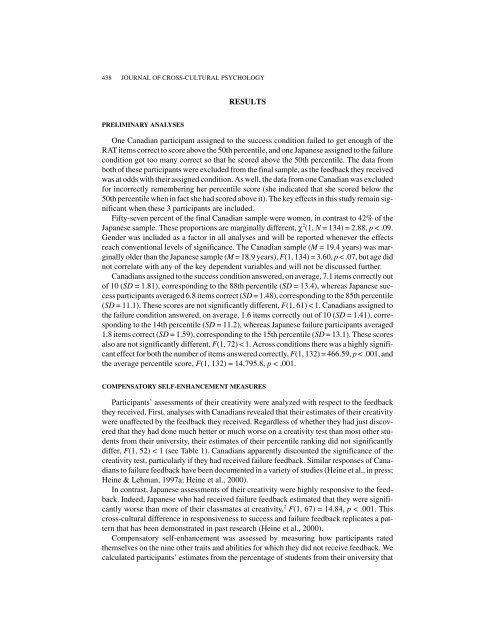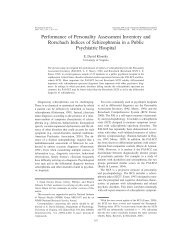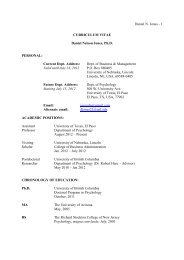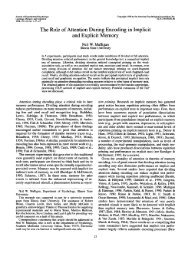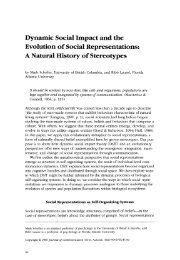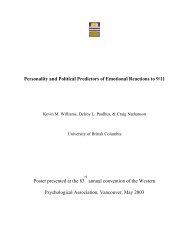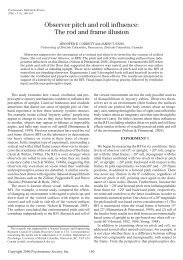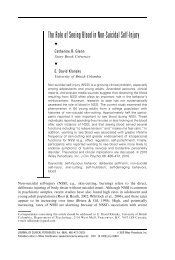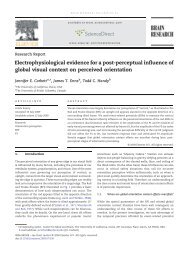CULTURAL DIFFERENCES IN SELF-EVALUATION Japanese ...
CULTURAL DIFFERENCES IN SELF-EVALUATION Japanese ...
CULTURAL DIFFERENCES IN SELF-EVALUATION Japanese ...
Create successful ePaper yourself
Turn your PDF publications into a flip-book with our unique Google optimized e-Paper software.
438 JOURNAL OF CROSS-<strong>CULTURAL</strong> PSYCHOLOGYRESULTSPRELIM<strong>IN</strong>ARY ANALYSESOne Canadian participant assigned to the success condition failed to get enough of theRAT items correct to score above the 50th percentile, and one <strong>Japanese</strong> assigned to the failurecondition got too many correct so that he scored above the 50th percentile. The data fromboth of these participants were excluded from the final sample, as the feedback they receivedwas at odds with their assigned condition. As well, the data from one Canadian was excludedfor incorrectly remembering her percentile score (she indicated that she scored below the50th percentile when in fact she had scored above it). The key effects in this study remain significantwhen these 3 participants are included.Fifty-seven percent of the final Canadian sample were women, in contrast to 42% of the<strong>Japanese</strong> sample. These proportions are marginally different, χ 2 (1, N = 134) = 2.88, p < .09.Gender was included as a factor in all analyses and will be reported whenever the effectsreach conventional levels of significance. The Canadian sample (M = 19.4 years) was marginallyolder than the <strong>Japanese</strong> sample (M = 18.9 years), F(1, 134) = 3.60, p < .07, but age didnot correlate with any of the key dependent variables and will not be discussed further.Canadians assigned to the success condition answered, on average, 7.1 items correctly outof 10 (SD = 1.81), corresponding to the 88th percentile (SD = 13.4), whereas <strong>Japanese</strong> successparticipants averaged 6.8 items correct (SD = 1.48), corresponding to the 85th percentile(SD = 11.1). These scores are not significantly different, F(1, 61) < 1. Canadians assigned tothe failure condition answered, on average, 1.6 items correctly out of 10 (SD = 1.41), correspondingto the 14th percentile (SD = 11.2), whereas <strong>Japanese</strong> failure participants averaged1.8 items correct (SD = 1.59), corresponding to the 15th percentile (SD = 13.1). These scoresalso are not significantly different, F(1, 72) < 1. Across conditions there was a highly significanteffect for both the number of items answered correctly, F(1, 132) = 466.59, p < .001, andthe average percentile score, F(1, 132) = 14,795.8, p < .001.COMPENSATORY <strong>SELF</strong>-ENHANCEMENT MEASURESParticipants’ assessments of their creativity were analyzed with respect to the feedbackthey received. First, analyses with Canadians revealed that their estimates of their creativitywere unaffected by the feedback they received. Regardless of whether they had just discoveredthat they had done much better or much worse on a creativity test than most other studentsfrom their university, their estimates of their percentile ranking did not significantlydiffer, F(1, 52) < 1 (see Table 1). Canadians apparently discounted the significance of thecreativity test, particularly if they had received failure feedback. Similar responses of Canadiansto failure feedback have been documented in a variety of studies (Heine et al., in press;Heine & Lehman, 1997a; Heine et al., 2000).In contrast, <strong>Japanese</strong> assessments of their creativity were highly responsive to the feedback.Indeed, <strong>Japanese</strong> who had received failure feedback estimated that they were significantlyworse than more of their classmates at creativity, 2 F(1, 67) = 14.84, p < .001. Thiscross-cultural difference in responsiveness to success and failure feedback replicates a patternthat has been demonstrated in past research (Heine et al., 2000).Compensatory self-enhancement was assessed by measuring how participants ratedthemselves on the nine other traits and abilities for which they did not receive feedback. Wecalculated participants’ estimates from the percentage of students from their university that


